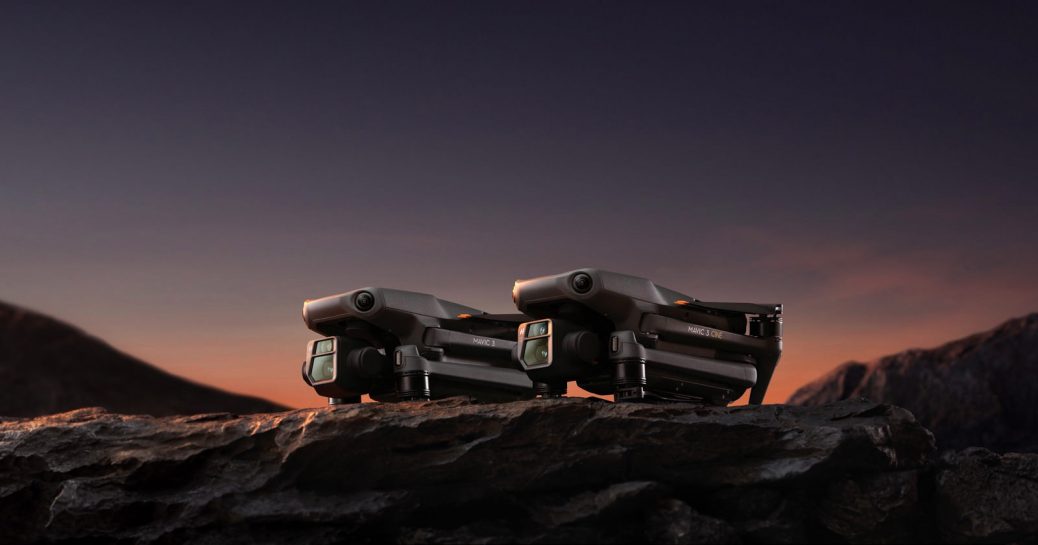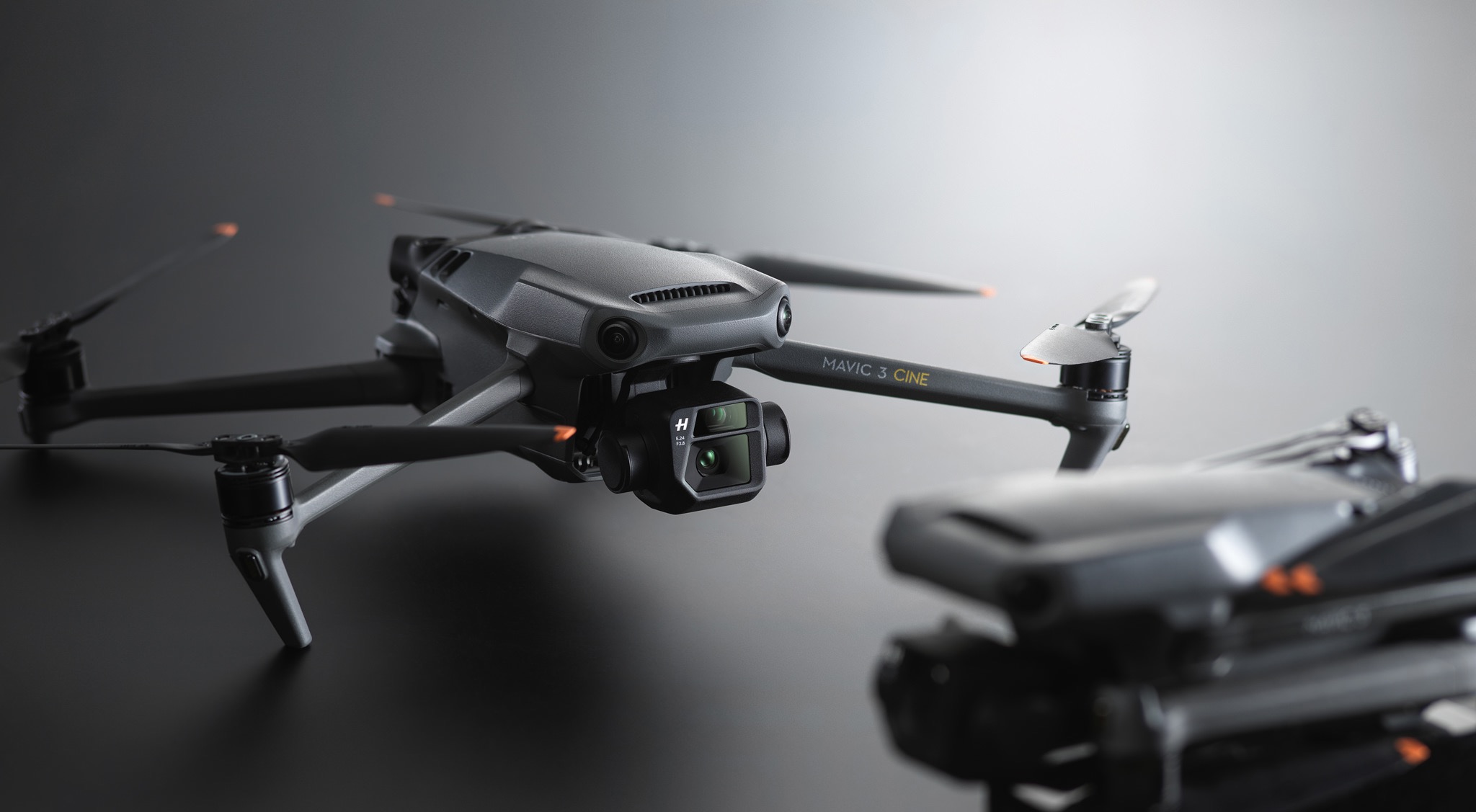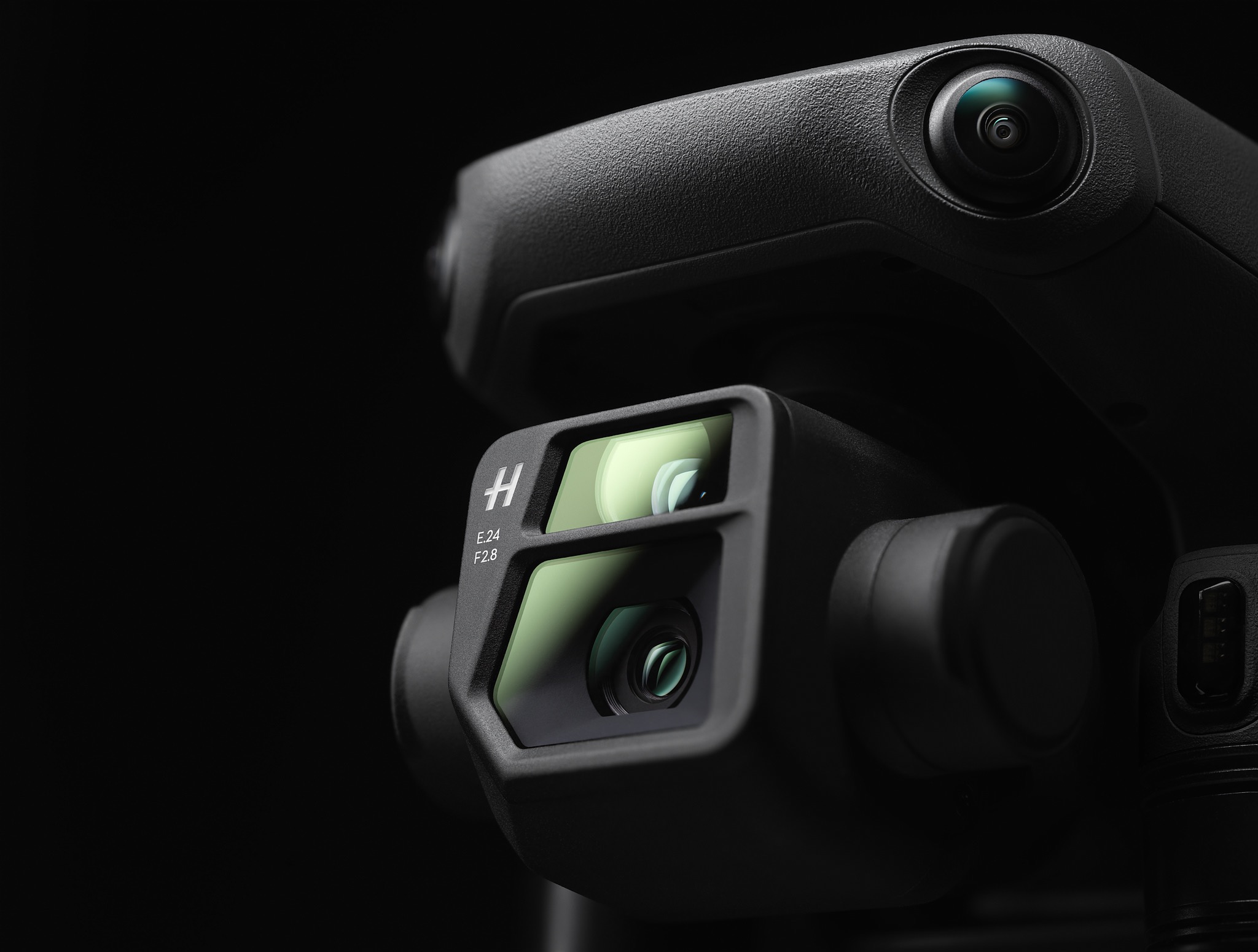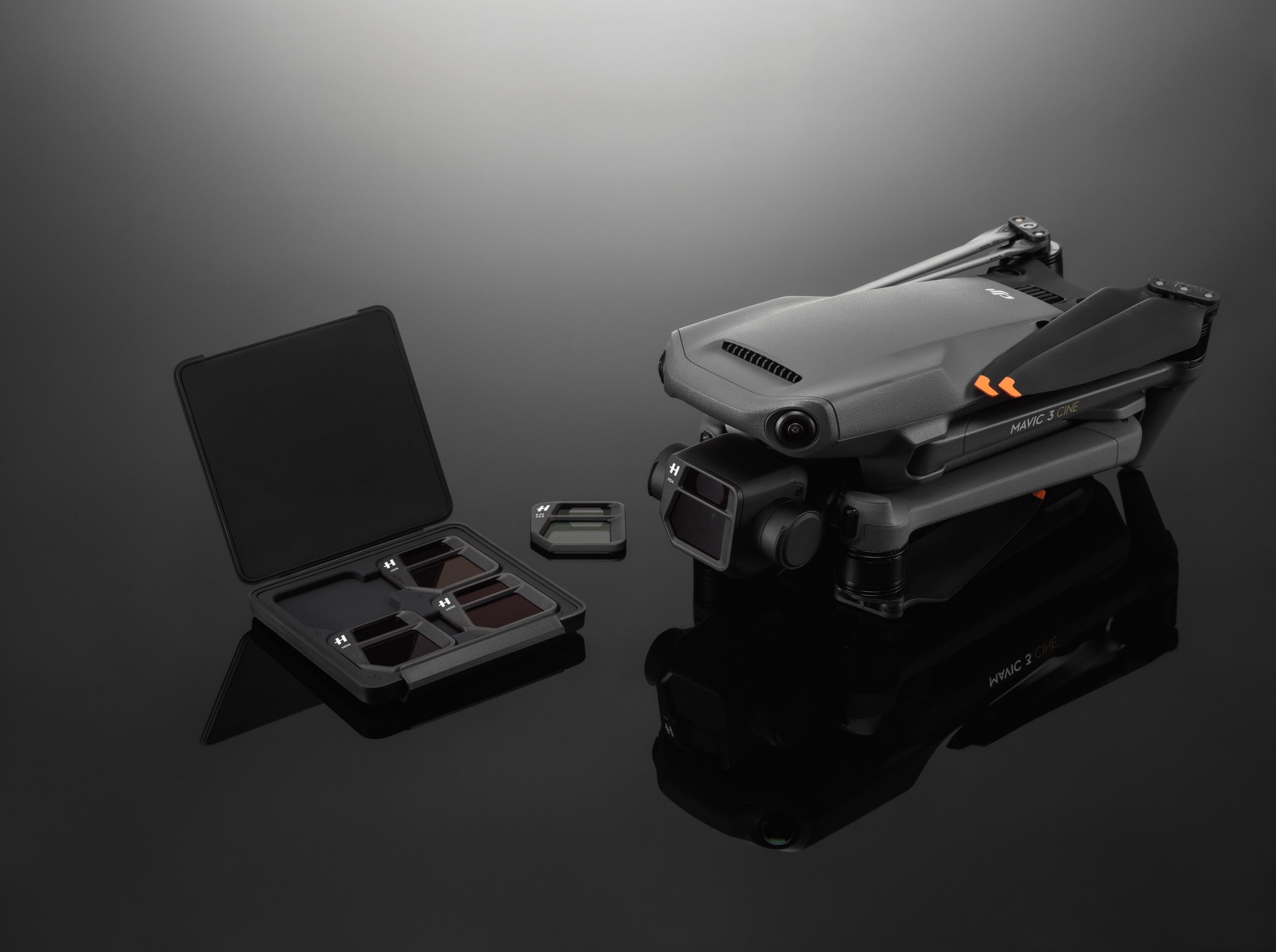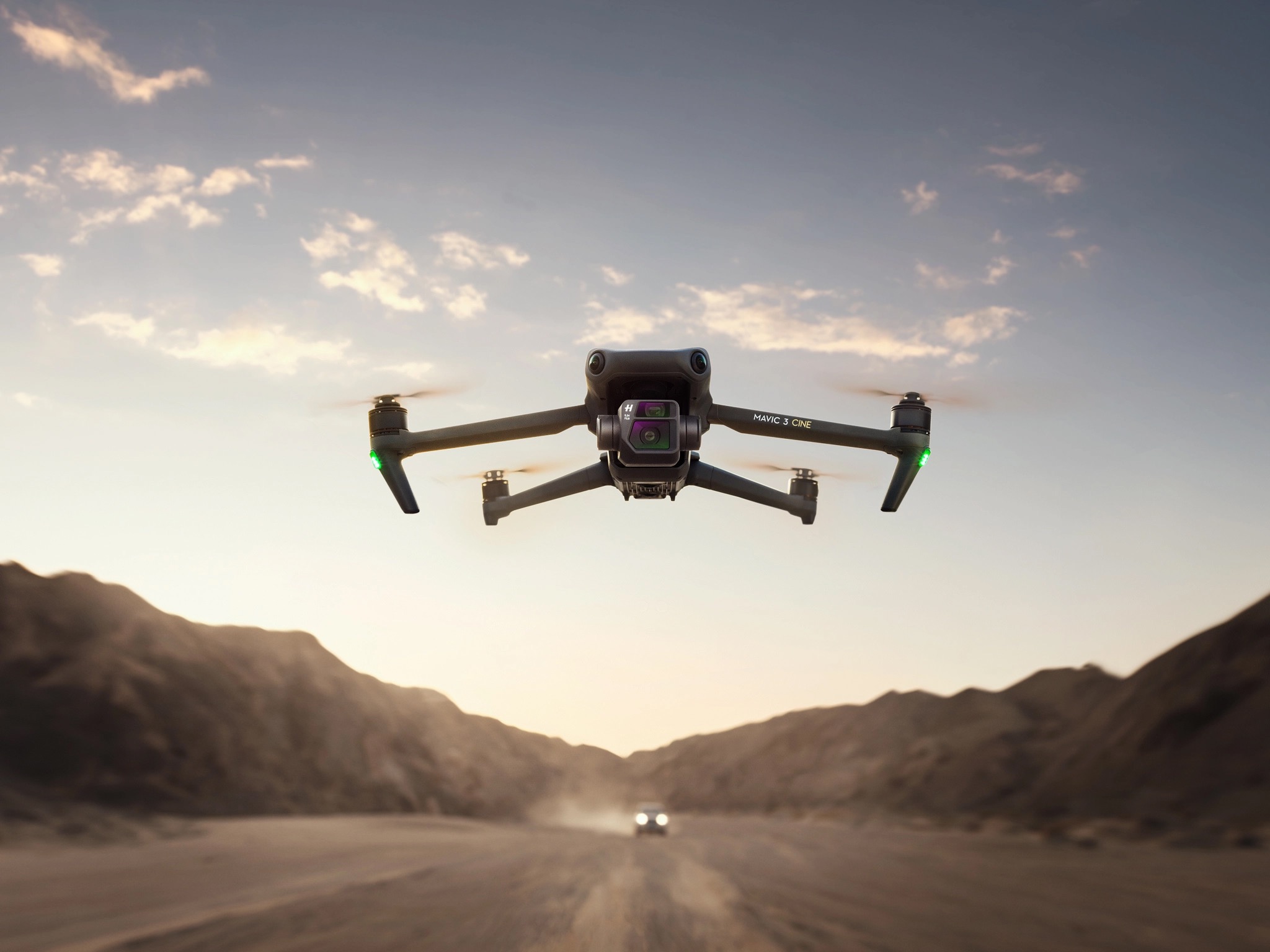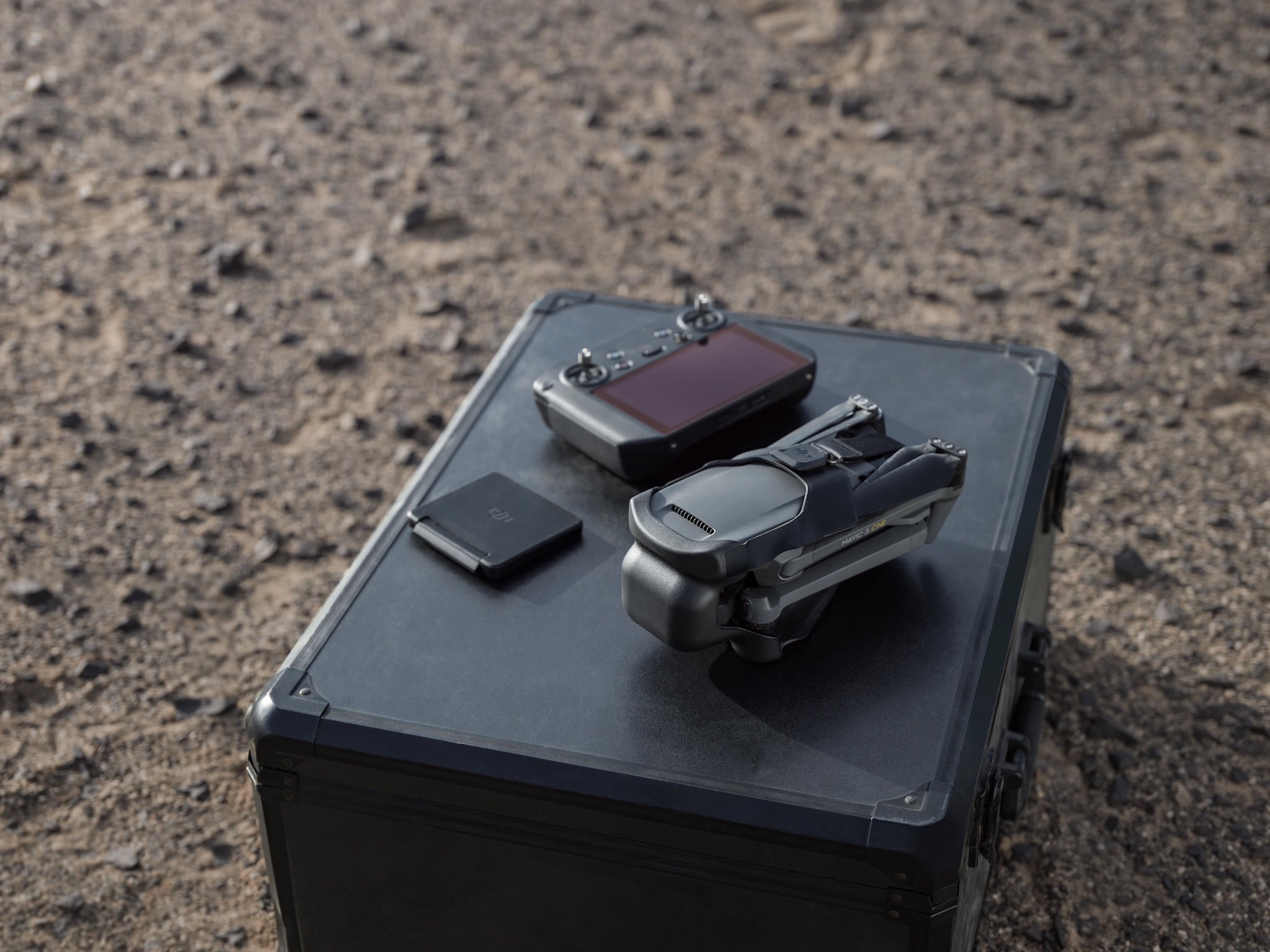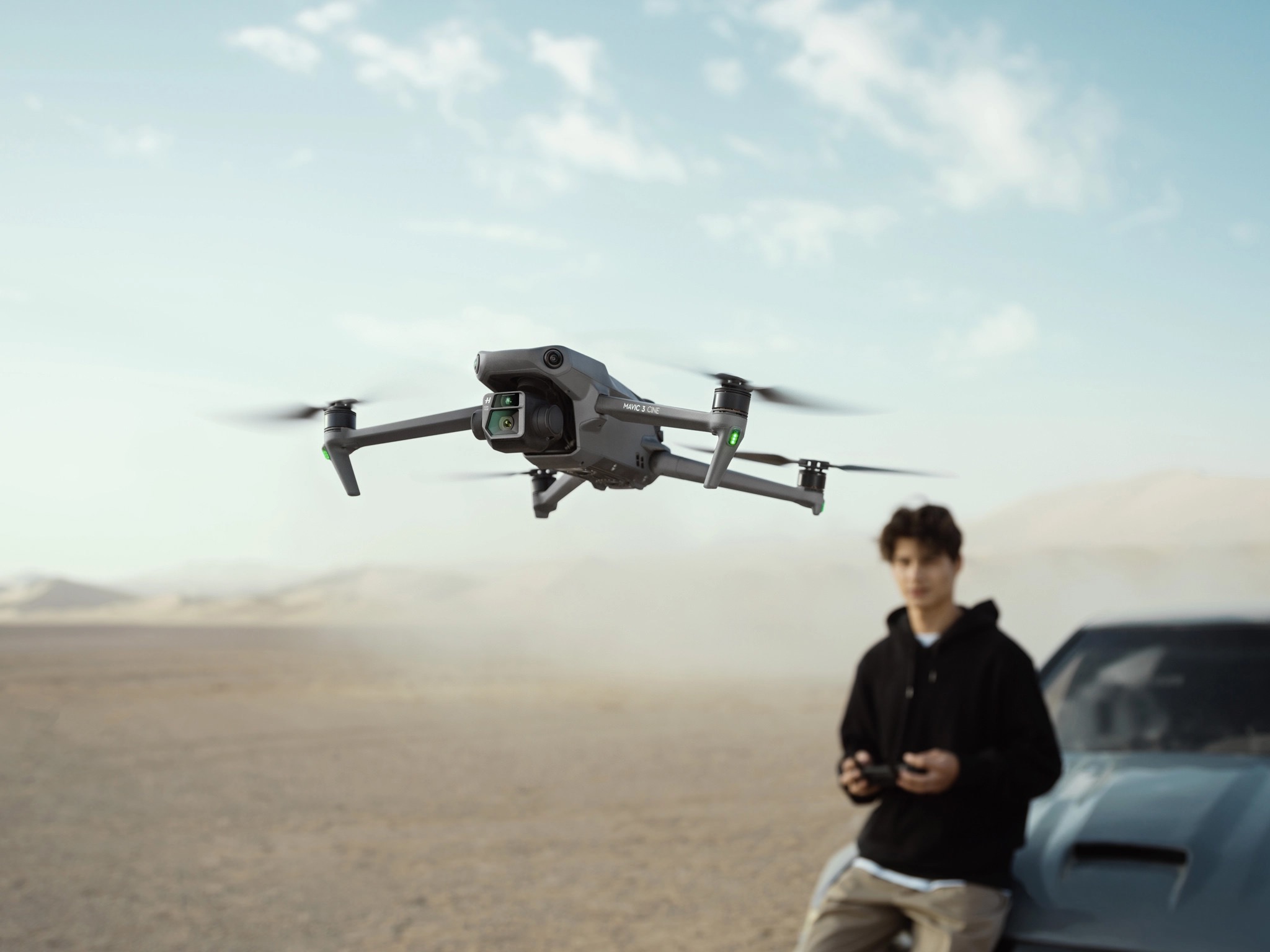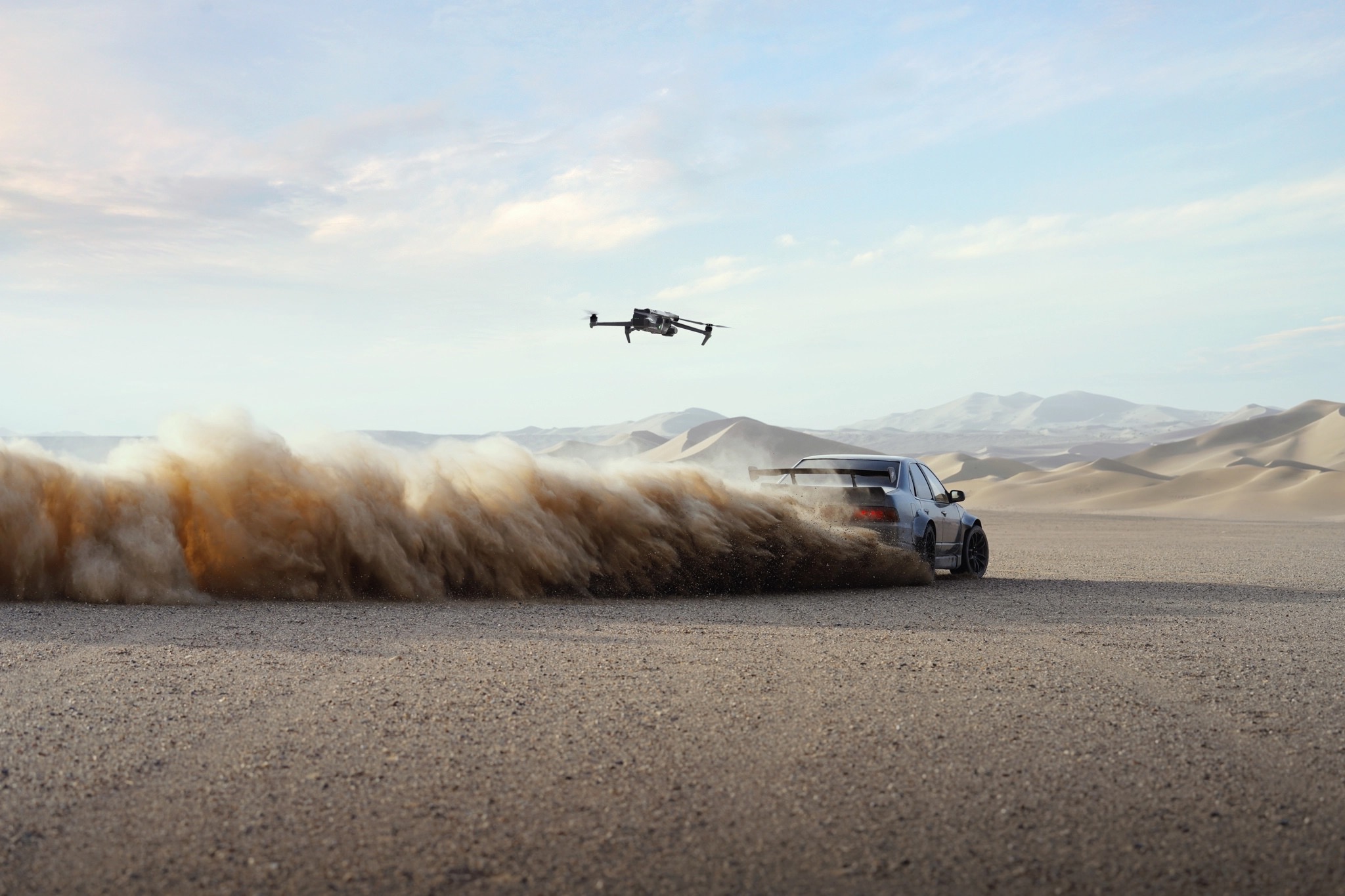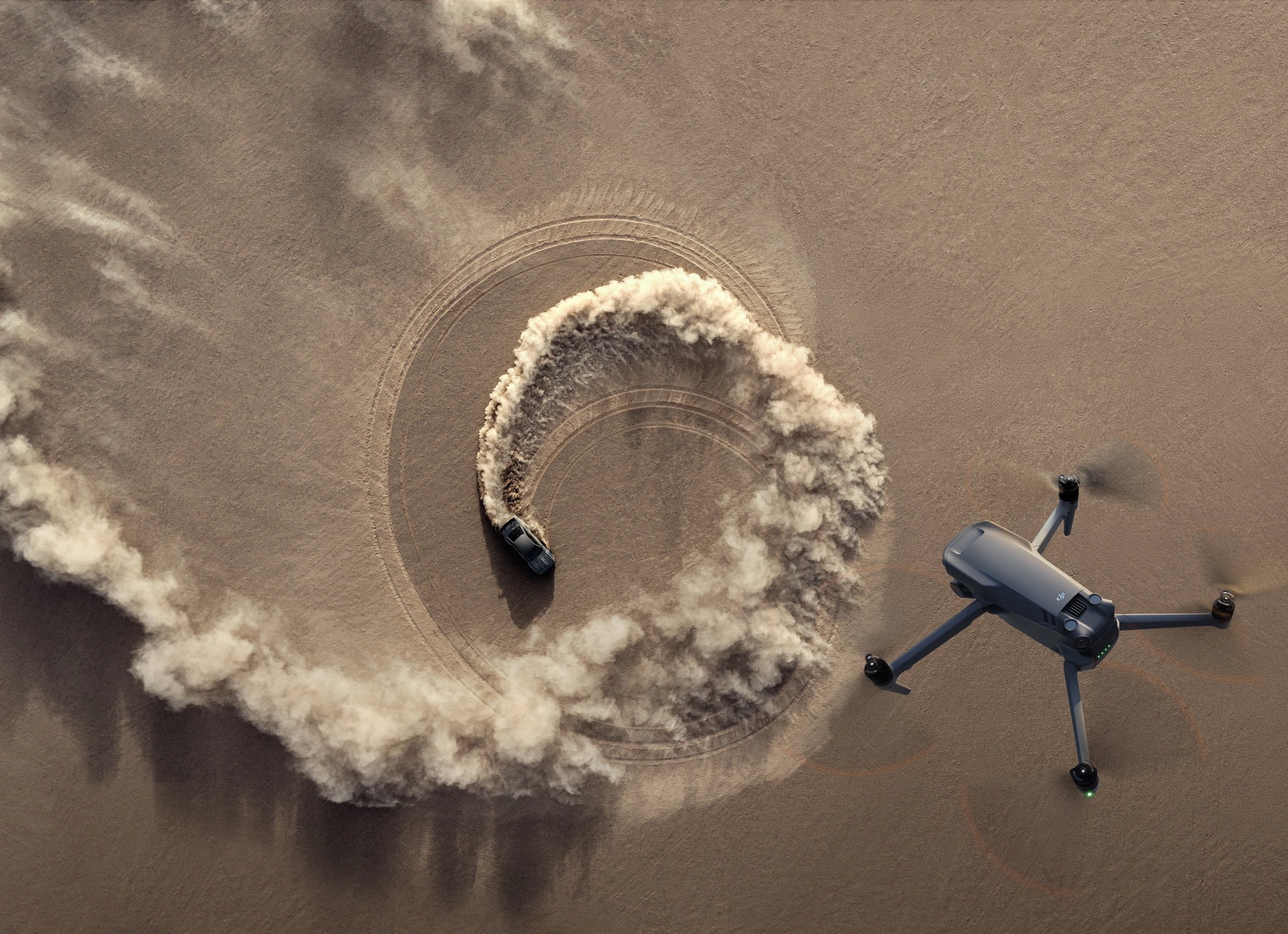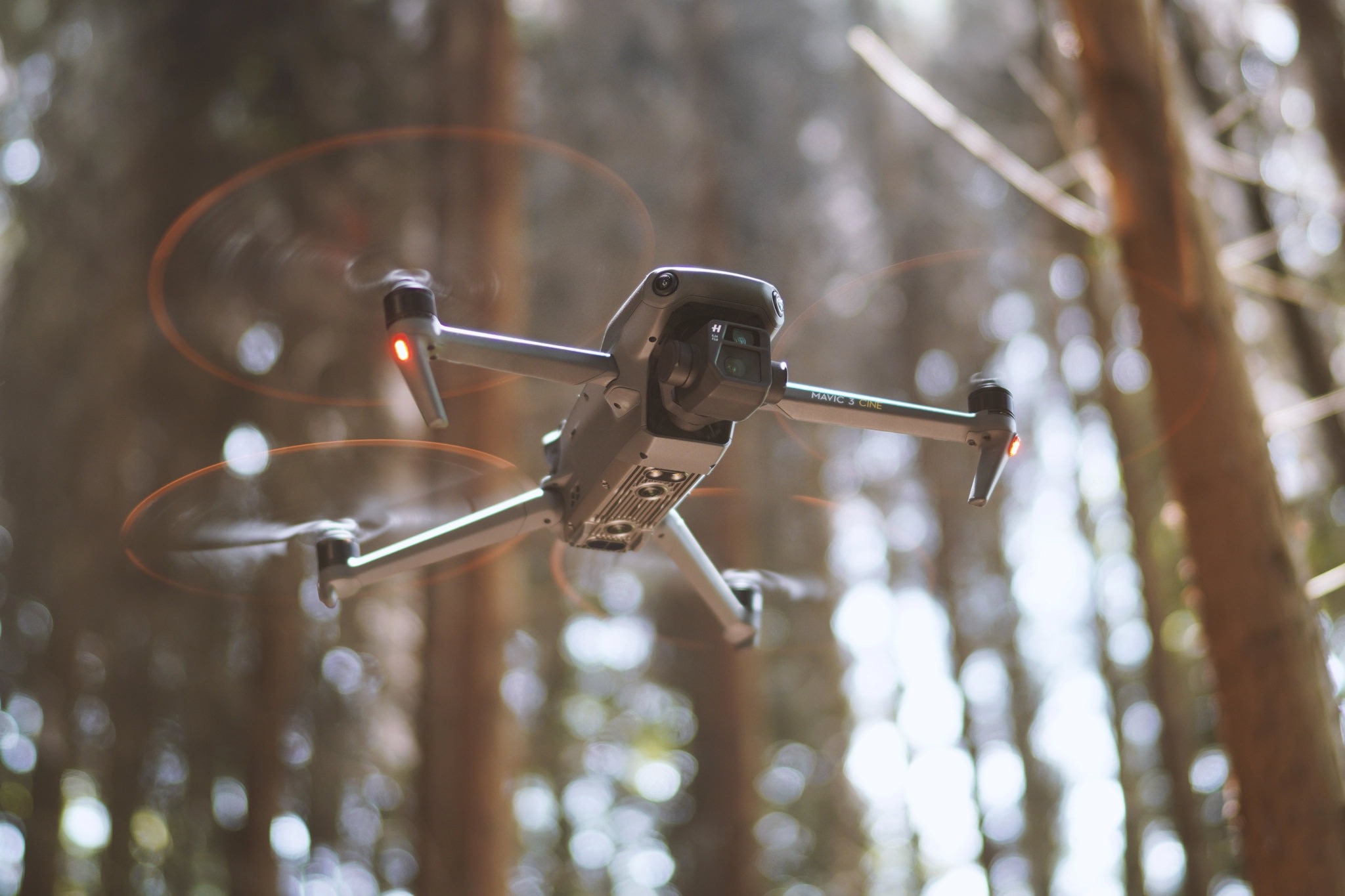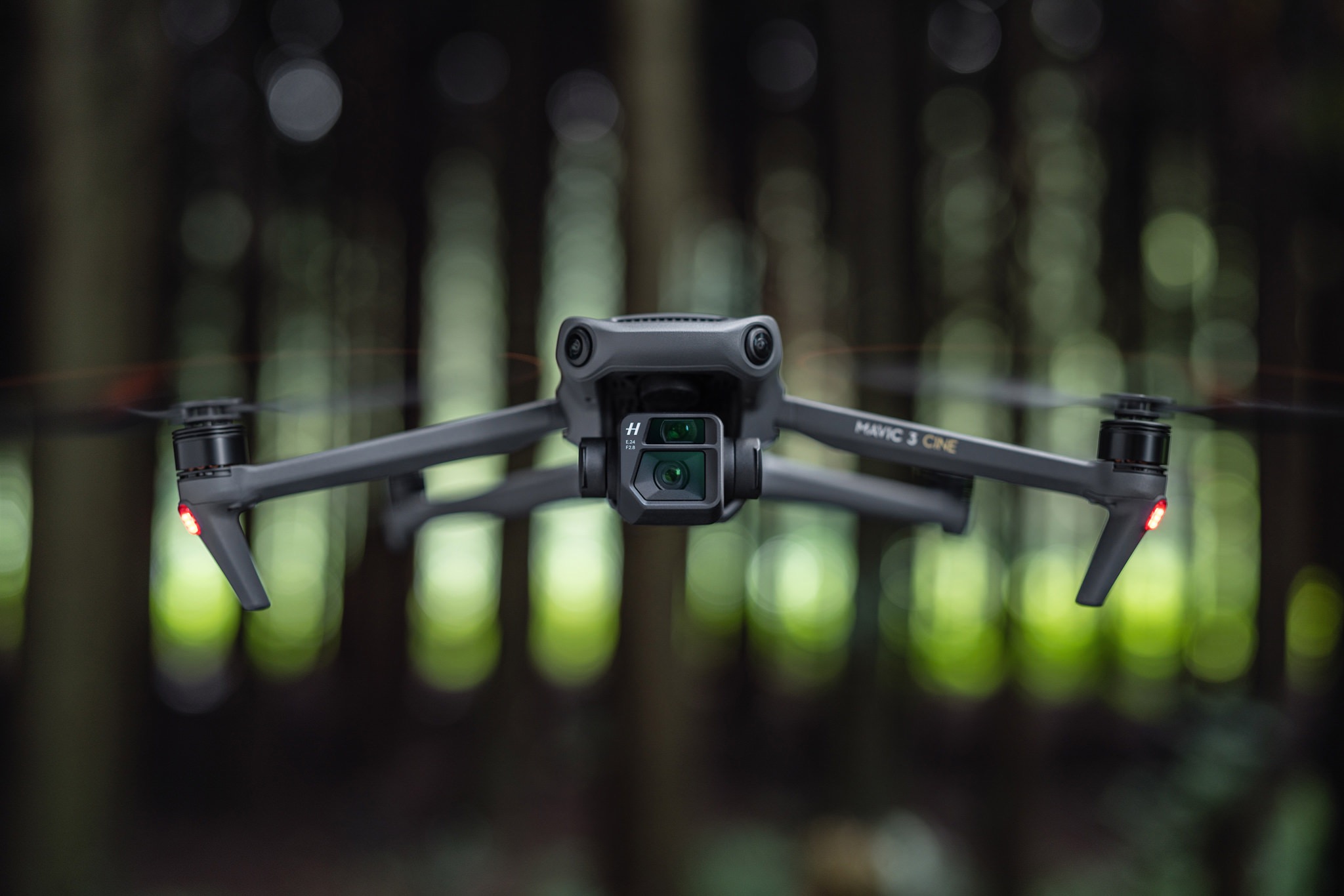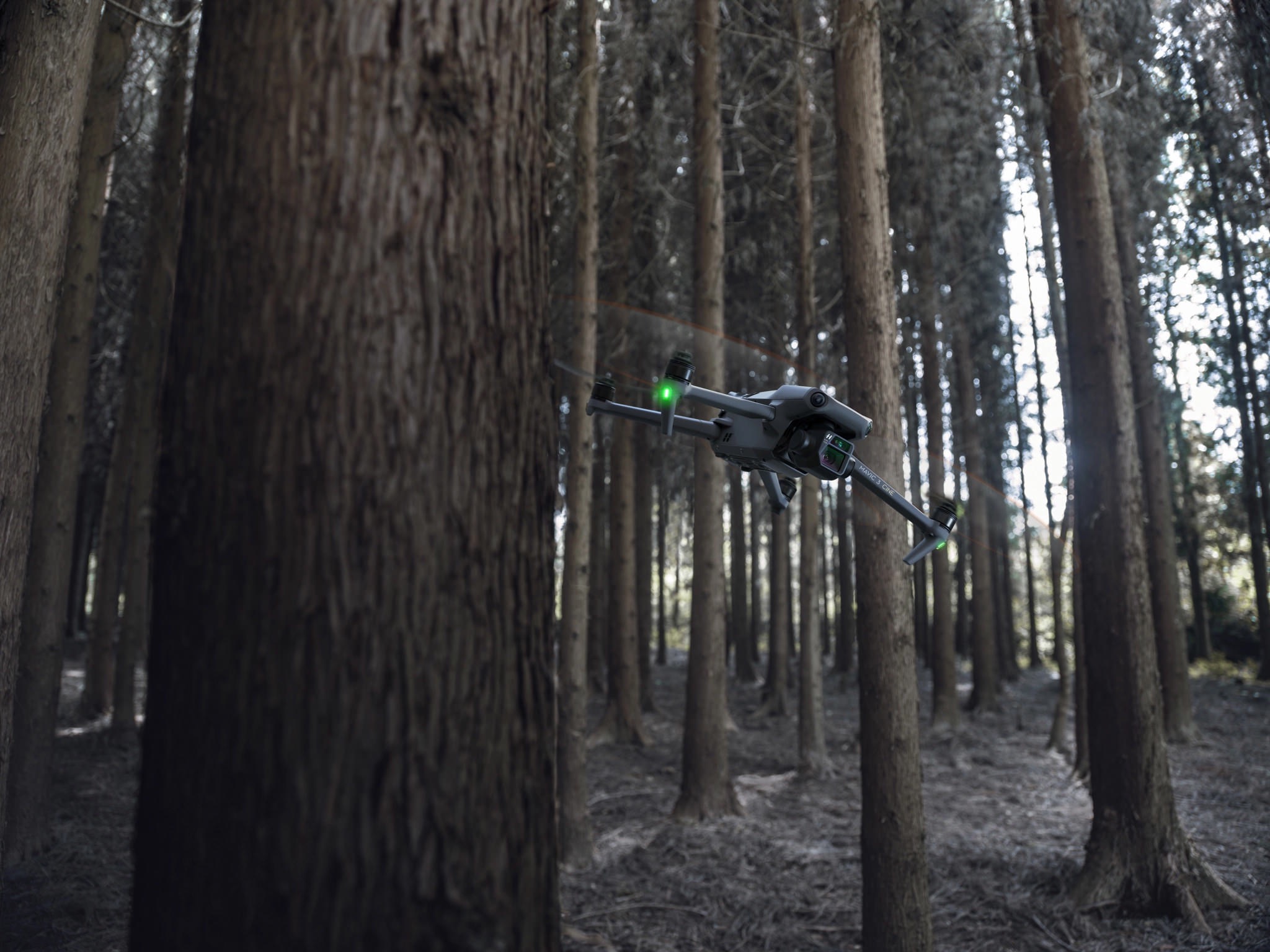DJI Announces the Mavic 3 and Mavic 3 Cine Dual-Camera Drones
DJI has announced the Mavic 3 and Mavic 3 Cine, the latest drones in its Mavic lineup that bring dual-camera systems with improved sensors, omnidirectional obstacle sensing, improved flight time, and more.
From its 4/3 CMOS Hasselblad camera and 28x hybrid zoom camera, to its omnidirectional obstacle sensors with a maximum 200-meter range, to its redesigned batteries that provide up to 46 minutes of flight time, Mavic 3 provides unprecedented flight performance and a peerless content creation experience. Its upgraded hardware and software can process 5.1K video at 50 frames per second in supple and nuanced color with heightened low-light sensitivity, and support 4K/120fps for higher-quality results for slow-motion footage.
An enhanced Mavic 3 Cine edition offers Apple ProRes 422 HQ encoding for richer video processing, with an internal 1TB SSD onboard for high-speed data storage. “Creating the Mavic 3 was an arduous journey for our engineers who tackled complex technical problems to serve the goal that the Mavic series has always met – build professional-quality imaging and flight technology into a compact consumer drone,” said Ferdinand Wolf, Creative Director, DJI Europe. “The result is incredible. Mavic 3 enables users to effortlessly make epic shots without compromising on the small size, stunning performance, pervasive flight safety, and dazzling image quality. We are confident that this drone will astonish videography and photography enthusiasts, as well as professional production houses and media workers around the globe.”
With A Dual-Camera System DJI pioneered the folding drone category in 2016 with the launch of the original Mavic Pro, which for the first time put professional-quality imaging in a body that could fit in a backpack. Two years later, Mavic 2 Pro launched DJI’s collaboration with iconic Swedish camera maker Hasselblad, integrating a one-inch sensor to push the boundaries of drone imagery further.
With its new dual-camera Hasselblad system, Mavic 3 once again sets the new standard for imaging excellence. DJI Mavic 3’s customized L2D-20c aerial camera embeds a professional-grade 4/3 CMOS sensor with a 24mm prime lens in a sleek and compact form. Rigorous Hasselblad standards for hardware performance and software algorithms allow it to shoot 20MP still images in 12-bit RAW format and videos in 5.1K at 50fps, 4K at 120fps.
The higher video definition creates smoother footage and more generous cropping possibilities and allows for slow-motion video at 120fps. The larger image sensor gives Mavic 3 higher video resolution and dynamic range and more effectively suppresses noise in low-light environments. A native dynamic range of 12.8 stops helps retain more details in highlights and shadows, preserving rich visual information with a greater sense of depth and elevating imagery to a professional level.
An adjustable aperture of f/2.8-f/11 is available to meet the needs of aerial photographers in a wide variety of lighting scenarios to get sharper and clearer images. Weighing just 12.5 grams, the 24mm equivalent autofocus prime lens has an 84° FOV to capture more details with sharp clarity. Mavic 3’s second camera features a 162mm tele lens with 28x Hybrid Zoom (digital + optical) and aperture of f/4.4 that can freely bring distant objects visually closer, offering the user more dynamic perspectives and creative possibilities at a distance.
The new Vision Detection Auto Focus technology for quick focusing allows the Hasselblad camera to work with multiple vision sensors on board to capture distance data to optimize focusing speed. Mavic 3 delivers a deeply accurate color palette straight out of its camera thanks to the unique Hasselblad Natural Colour Solution (HNCS), built on decades of photographic experience and introduced to DJI cameras with Mavic 2 Pro.
With professional imaging performance, Mavic 3 records aerial videos at high resolutions and framerates and captures up to 1 billion colors thanks to the 10-bit D-Log color profile, offering natural color gradations and advanced flexibility in postproduction. Mavic 3 Cine is a version with Apple ProRes 422 HQ encoding for a maximum data rate of 3772Mbps, giving professional users a powerful tool to satisfy post-production needs in their daily business. To handle the large amounts of data from the ProRes codec and high frame rate videos, Mavic 3 Cine comes with a built-in 1TB SSD. For a smoother export experience, the new DJI 10Gbps Lightspeed Data Cable helps transfer large data files rapidly.
DJI has always led the drone industry in developing innovative safety features, and Mavic 3 continues this tradition with improved obstacle sensing and navigation systems to give drone pilots the guidance they need to stay safe. APAS 5.0 combines inputs from six fish-eye vision sensors and two wide-angle sensors, which seamlessly and continuously sense obstacles in all directions and plan safe flight routes to avoid them – even in complicated environments.
The omnidirectional obstacle sensing system also enables more intuitive subject tracking with the upgraded ActiveTrack 5.0, allowing users to sense obstacles even in Normal mode. Previous iterations of ActiveTrack enabled the camera to follow a subject as it moved directly toward and away from the drone while remaining largely stationary as well as flying alongside a moving subject. ActiveTrack 5.0 allows Mavic 3 to move with the subject as it moves forward, backward, left, right, and diagonally, and fly alongside as well as around a moving subject. In addition, if the subject moves too fast and temporarily goes out of frame, the visual sensors on the camera body will continue to track and frame the subject intelligently and pick it back up when it reappears. These new directions enable much more fluid and diverse drone and camera movement while using ActiveTrack.
Mavic 3 comes with a powerful positioning algorithm that improves hovering precision with signals from GPS, GLONASS, and BeiDou satellites. This enables Mavic 3 to lock onto multiple satellite signals faster than ever. The increased positioning precision also makes Mavic 3 less likely to drift in the air and more stable when shooting long exposures and time-lapses. Mavic 3 features other robust safety systems that DJI has pioneered to keep the skies safe in the drone era. These include geofencing to alert drone pilots when they fly near sensitive locations, altitude limits to ensure pilots are aware of altitude restrictions, and the AeroScope Remote ID system that allows authorities to identify and monitor airborne drones in sensitive locations. Mavic 3’s integrated AirSense system, first introduced in DJI Air 2S, warns drone pilots of nearby airplanes and helicopters transmitting ADS-B signals, so they can quickly fly to a safer location.
DJI set a benchmark for drone endurance in 2016 with the Phantom 4 and the original Mavic Pro, which each featured maximum flight times approaching 30 minutes. In the succeeding years, new drone models have slowly increased those times thanks to incremental improvements in in-flight technology. With Mavic 3, DJI has reshaped every element of the drone’s flight envelope and power management to enable drastically longer flight times – up to 46 minutes in ideal conditions – giving unprecedented freedom for aerial photographers to shoot dynamic scenes. DJI developed motors and propellers with higher energy efficiency, created a higher-capacity battery, and reduced the weight of the drone’s structure and components. DJI also streamlined the shape of Mavic 3’s arms, body, and gimbal on aerodynamic principles. Wind tunnel testing shows Mavic 3 produces 35% less drag than previous generations, allowing faster top speeds.
DJI’s Return To Home (RTH) system has enhanced the safety of DJI drones for years, automatically directing a drone back to its starting point if it runs critically low on battery or loses connection to the controller. The drone would ascend high enough to clear any obstacles in its path, fly back in a straight line, and descend straight down to the home point. Mavic 3 updates and improves this system by allowing the aircraft to automatically determine the shortest, safest, and energy-efficient route to land back at its home point. At the same time, the drone measures the wind speed of the current environment and calculates the power required for returning home based on the wind speed and the return path in real-time. This provides users with more time to fly safely before triggering the RTH action.
DJI O3+ is an upgraded transmission system that delivers stable, smooth, and clear video transmission even under challenging conditions, such as flying a drone in an environment with strong signal interference. With a maximum control range of 15km, O3+ enables Mavic 3 to fly further and transmits signals with higher stability and less video lag, offering the pilot a greater peace of mind during flight. Mavic 3 is DJI’s first drone that offers a High Frame-Rate Transmission with a 1080p/60fps live feed. This means the camera view is displayed at a resolution close to what the camera actually records. O3+ also makes Mavic 3 more responsive to the pilot’s control. A new layer of flight safety is offered by the DJI Cellular Transmission Dongle, an accessory that attaches securely to Mavic 3. The dongle allows Mavic 3 to seamlessly coordinate the O3+ transmission system with 4G networks for a smooth, stable connection when O3+ signals are blocked by buildings, trees, or other structures. This allows users to have a safer and more reliable flight experience when photographing buildings flying at low altitudes or navigating through obstacles.
Mavic 3 offers a new array of Intelligent modes for creating and editing compelling photos and videos by controlling the flight path and camera movements in compelling new ways. These features, such as MasterShots and QuickTransfer, allow users to make the most out of their drone.
- MasterShots lets users create high-quality content more easily and quickly. After automatic editing and dubbing in the app, videos can be created in minutes and directly shared with friends.
- QuickTransfer lets users store and process materials on their mobile devices without linking with the remote controller. Mavic 3 can now transmit materials from the drone to the mobile device more quickly through the Wi-Fi 6 protocol. New, Advanced Accessories Along with a suite of new features and performance innovations, DJI introduces new ways to control, capture with, and carry DJI Mavic 3.
- The new smart controller DJI RC Pro offers a smoother control experience, upgraded with enhanced antenna power for an extended transmission distance of up to 15 km. Its 1000- nit high-bright screen allows better vision and control for outdoor flights. Its battery system offers an extended operating time of up to three hours and charging as fast as 90 minutes.
- The DJI 65W Portable Charger allows a fast-charging option with a charging time of approximately 96 minutes and is compatible with current notebooks and smartphones thanks to its USB Type-C output.
- The DJI Convertible Carrying Bag features an entirely new design with a backpack and shoulder bag configuration for taking Mavic 3, accessories, a laptop, and even clothes and other personal items for a weekend trip in style.
- The DJI Mavic 3 Wide-Angle Lens offers a FOV of up to 108° for a more immersive FPVstyle flight experience.
- The DJI Mavic 3 Storage Cover uses a lightweight, minimalist design to protect the camera, gimbal, and propellers when folding and transporting Mavic 3.
- The DJI ND Filters Set comes in two ranges – ND4/8/16/32 and ND64/128/256/512 – and lets the camera excel in any bright lighting condition.
- The DJI 10Gbps Lightspeed Data Cable enables users to download materials from the drone to their computer at high speed. Material backup is available on-site, thanks to high-speed transmission.
The Mavic 3 Standard version retails for $2,199 and includes the drone, one Intelligent Flight Battery, an RC-N1 Remote Controller, an RC-N1 cable, the battery charger, storage cover, and three pairs of spare propellers.
The DJI Mavic 3 Fly More Combo retails for $2,999 and includes Mavic 3 the drone, three Intelligent Flight Batteries, an RC-N1 Remote Controller, three RC-N1 cables, a battery charging hub, storage cover, six pairs of spare propellers, the ND filters set (ND4\8\16\32), and the bag.
The DJI Mavic 3 Cine Premium Combo retails for $4,999 and, as previously noted, includes a built-in 1TB SSD and supports Apple ProRes 422 HQ video recording. The Mavic 3 Cine Premium Combo also includes a lot more accessories and components, including three Intelligent Flight Batteries, a DJI RC Pro remote controller, three RC-N1 cables, a battery charger, a battery charging hub, storage cover, six pairs of spare propellers, two ND filters sets (ND4\8\16\32 and ND64\128\256\512), DJI 10Gbps data cable, and the bag.
More info on DJI’s website.

